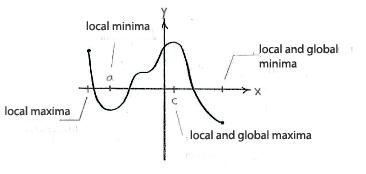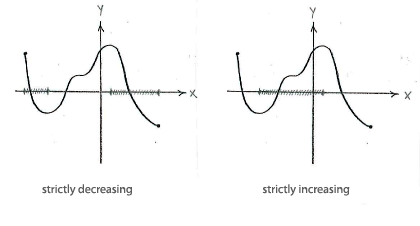Lösung 1.3:1c
Aus Online Mathematik Brückenkurs 2
K |
|||
| Zeile 1: | Zeile 1: | ||
| - | The function has zero derivative at three points, | + | The function has zero derivative at three points, <math>x=a</math>, <math>x=b</math> and <math>x=c</math> (see picture below), which are therefore the critical points of the function. |
| - | <math>x=a</math>, | + | |
| - | <math>x=b</math>and | + | |
| - | <math>x=c</math> | + | |
| - | (see picture below), which are therefore | + | |
[[Image:1_3_1_c1.gif|center]] | [[Image:1_3_1_c1.gif|center]] | ||
| - | The point | + | The point <math>x=b</math> is an inflexion point because the derivative is positive in a neighbourhood both to the left and right. |
| - | <math>x=b</math> | + | |
| - | is an inflexion point because the derivative is positive in a neighbourhood both the left and right. | + | |
| - | At the left endpoint of the interval of definition and at | + | At the left endpoint of the interval of definition and at <math>x=c</math>, the function has local maximum points , because the function takes lower values at all points in the vicinity of these points. At the point <math>x=a</math> and the right endpoint, the function has local minimum points. |
| - | <math>x=c</math>, the function has local maximum points , because the function takes lower values at all points in the vicinity of these points. At the point | + | |
| - | <math>x=a</math> | + | |
| - | and the right endpoint, the function has local minimum points | + | |
| - | + | ||
| - | + | ||
| - | + | ||
| - | + | ||
| + | Also, we see that <math>x=c</math> is a global maximum (the function takes its largest value there) and the right endpoint is a global minimum. | ||
[[Image:1_3_1_c2.gif|center]] | [[Image:1_3_1_c2.gif|center]] | ||
| - | Between the left endpoint and | + | Between the left endpoint and <math>x=a</math>, as well as between <math>x=c</math> |
| - | <math>x=a</math>, as well as between | + | and the right endpoint, the function is strictly decreasing (the larger <math>x</math> is, the smaller <math>f(x)</math> becomes), whilst the function is strictly increasing between <math>x=a</math> and <math>x=c</math> (the graph flattens out at <math>x=b</math>, but it isn't constant there). |
| - | <math>x=c</math> | + | |
| - | and the right endpoint, the function is strictly decreasing (the larger | + | |
| - | <math>x</math> | + | |
| - | is, the smaller | + | |
| - | <math>f | + | |
| - | becomes), whilst the function is strictly increasing between | + | |
| - | <math>x=a</math> | + | |
| - | and x=c (the graph flattens out at | + | |
| - | <math>x=b</math>, but it isn't constant there). | + | |
| - | + | ||
[[Image:1_3_1_c3.gif|center]] | [[Image:1_3_1_c3.gif|center]] | ||
Version vom 12:03, 17. Okt. 2008
The function has zero derivative at three points, \displaystyle x=a, \displaystyle x=b and \displaystyle x=c (see picture below), which are therefore the critical points of the function.
The point \displaystyle x=b is an inflexion point because the derivative is positive in a neighbourhood both to the left and right.
At the left endpoint of the interval of definition and at \displaystyle x=c, the function has local maximum points , because the function takes lower values at all points in the vicinity of these points. At the point \displaystyle x=a and the right endpoint, the function has local minimum points.
Also, we see that \displaystyle x=c is a global maximum (the function takes its largest value there) and the right endpoint is a global minimum.
Between the left endpoint and \displaystyle x=a, as well as between \displaystyle x=c and the right endpoint, the function is strictly decreasing (the larger \displaystyle x is, the smaller \displaystyle f(x) becomes), whilst the function is strictly increasing between \displaystyle x=a and \displaystyle x=c (the graph flattens out at \displaystyle x=b, but it isn't constant there).



